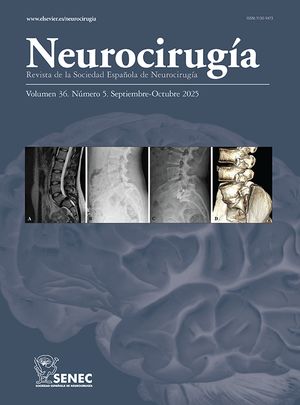Valorar la utilidad clínica de dos métodos en la medición de la presión intracraneal (PIC): registro intraparenquimatoso (PICc) y registro epidural (PICe), comparándolo con la PIC intraventricular (PICv) como referencia.
Material y métodoSe estudiaron prospectivamente 13 pacientes ingresados entre Febrero 1990 y Diciembre 1993, tras sufrir traumatismo craneoencefálico grave (Glasgows 8). En todos los pacientes se obtuvo una PICv mediante columna de agua con catéter multiperforado. En 6 pacientes se registró la PICc mediante transductor de fibra óptica (Camino V420R), yen los 7 restantes la PICe con sistema acoplado a fluido. (PlastimedR). Se colocó el registro estudio contralateral al de referencia (PICv). Las tomografías computarizadas (TC) realizadas en estos pacientes mostraron lesiones clasificadas como focales (cuando existía una lesión localizada, ocupante o no de espacio), difusas (cuando el grado de afectación de la lesión era generalizado), o mixtas (cuando presentaban los 2 tipos de lesiones). La PICc fue medida homolateral a la lesión focal en 3 casos y contralateral en 2; la PICe se midió homolateral a la lesión focal en 2 casos y contralateral en 3. La calibración de los 3 sistemas se realizó a nivel del pabellón auricular. Se realizó un análisis estadístico (coeficientes de correlación entre PICc-PICv y entre PICe-PICv de manera global con todos los pacientes e individualmente con cada uno de ellos) de los pares horarios de mediciones obtenidas por el registro estudio y el de referencia y durante todo el tiempo de asistencia (5,5 días de media para PICc y 4,85 para PICe).
ResultadosEn los 6 pacientes estudiados, se observó una correlación PICc-PICv con un coeficiente de r=0,84 (P<0,001) y una recta de regresión Y= −0,85 + 0,93X. De manera individual se observó una r>0,78 en 4 de los 6 casos. En 7 pacientes la correlación PICe-PICv mostró un coeficiente r=0,47 (P<0,001), con una recta de regresión Y=7,2 + 0,43X. La correlación individual fue <0,5 en todos los casos. El estudio de correlación para cortes de PICv>20mmHg, >25mmHg y >30mmHg mostró para PICc una r de 0,89, de 0,94 y de 0,97 respectivamente, y par PICe una r de 0,25, 0,13 y 0,009 respectivamente.
ConclusionesEn nuestra serie la PICc se valora como un buen sistema de medición de la PIC. La PICe infravalora de forma significativa los valores de la PIC. En situaciones de hipertensión endocraneal, la correlación PICc-PICv es óptima y no es correcta en caso de PICe-PICv, con sistema acoplado a fluidos.
Evaluate the clinical usefulness of two different méthods of intra-cranial pressure (ICP) measurement: intraparenchymal (ICPc) and epidural (ICPe) monitoring as compared with intra-ventricular measurement (ICPv) as a reference.
Material and MethodTherteen patients, admitted between February 1990 and December 1993 were prospectively studied. All patients had suffered severe cranial trauma (Glasgow<8). ICPv was measured in all patients using an intraventricular catheter. Six of the patients had the ICPc registered using an optic fiber transducer (Camino V420R), while the other seven had the ICPe registered with a fluid coupling system (PlastimedR). Both ICPc ad ICPe were measured contralateral to the reference (ICPv).
Computerized tomographies (CT) findings in these patients were classified into: focal, when there was a localized lesion, with or without mass effect, diffuse, when there was not focal mass effect, or mixed, when both lesions were present. ICPc was measured ipsilaterally to the lesion in two cases and contralaterally in three cases. A statistical analysis was carried out (correlation coefficients between ICPc-ICPv and between ICPe-ICPv both globally and in the individual patient) of the hourly ICP measurements obtained with study recordings during the monitoring period (average duration: 5.5 days with ICPc and 4.85 with ICPe).
ResultsIn the 6 patients in which ICPc-ICPv were compared, the correlation coefficient was r=0.84 (P<0.001) with a regression line of Y=0.85 + 0.93X. Individually a coefficient r>0.78 was observed in 4 of the 6 cases. Of the 7 patients in which ICPe-ICPv were compared, the correlation coefficient was r=0.47 (P<0.001) with a regression line of Y=7.2 + 0.43X. The individual correlation was <0.5 in all cases. The correlation study for cuts, of ICPv >20mmHg, >25mmHg and >30mmHg showed r values for ICPc of 0.89, 0.94 and 0.97 respectively, and r values for ICPe of 0.25, 0.13, and 0.009 respectively.
ConclusionsIn the present study ICPc was seen to be a valid measurement of ICP. ICPe significantly underrated ICP values. In conditions of intracranial hypertension, the correlation between ICPc-ICPv is very good while is not correct between ICPe and ICP-v.
Artículo

Si es la primera vez que accede a la web puede obtener sus claves de acceso poniéndose en contacto con Elsevier España en suscripciones@elsevier.com o a través de su teléfono de Atención al Cliente 902 88 87 40 si llama desde territorio español o del +34 932 418 800 (de 9 a 18h., GMT + 1) si lo hace desde el extranjero.
Si ya tiene sus datos de acceso, clique aquí.
Si olvidó su clave de acceso puede recuperarla clicando aquí y seleccionando la opción "He olvidado mi contraseña".







